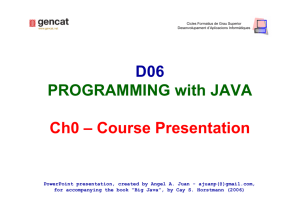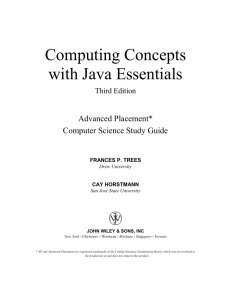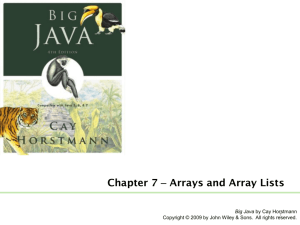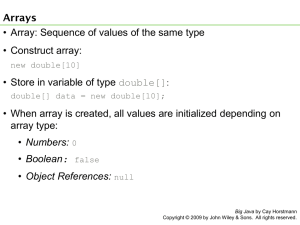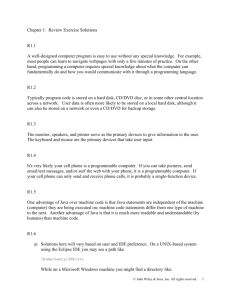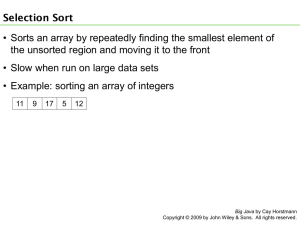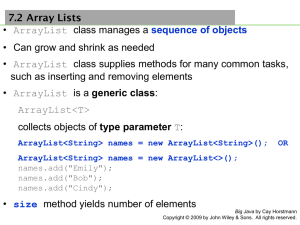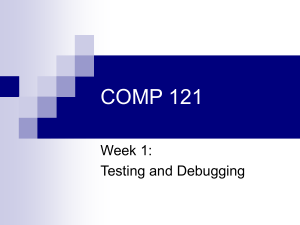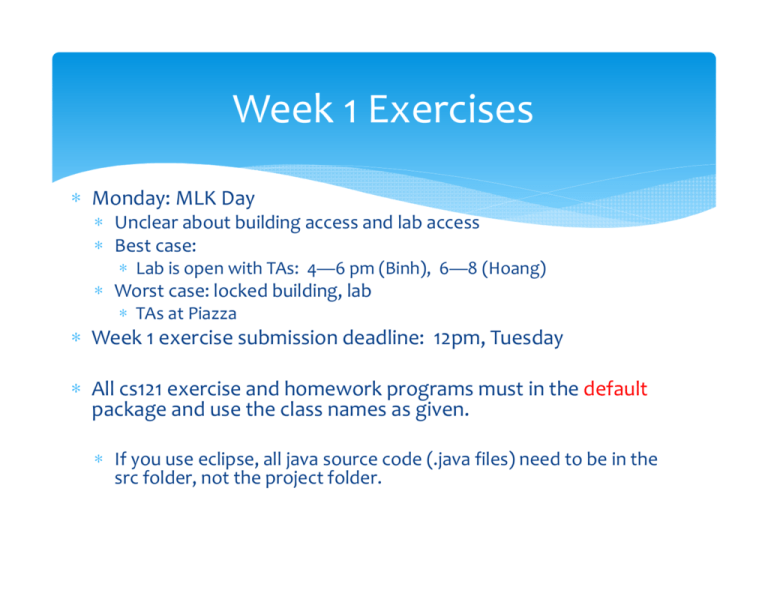
Week 1 Exercises
∗ Monday: MLK Day
∗ Unclear about building access and lab access
∗ Best case:
∗ Lab is open with TAs: 4—6 pm (Binh), 6—8 (Hoang)
∗ Worst case: locked building, lab
∗ TAs at Piazza
∗ Week 1 exercise submission deadline: 12pm, Tuesday
∗ All cs121 exercise and homework programs must in the default
package and use the class names as given.
∗ If you use eclipse, all java source code (.java files) need to be in the
src folder, not the project folder.
Problem Solving Example
∗ Flash Mind Reader
∗ Different tables at different runs
∗ Apparent random choice for users
∗ Final outcome
∗ deterministic for each table
∗ Same symbol regardless of user
choice
∗ More information, including the
proof, can be found in the complete
slides (now liked from cs121 site)
∗ Problem solving processes:
specializing, generalizing,
conjecturing, convincing
∗ (Reminder: take Math 114 this
semester, a prerequisite for
several int. CS courses)
Some of the slides on testing are adopted from
slides from
• Big Java, Horstmann
• Introduction to Computing, Sedgewick and Wayne
Errors
• Compile-time error: A violation of the programming language
rules that is detected by the compiler
• Example:
System.ou.println("Hello, World!);
• Syntax error
• Run-time error: Causes the program to take an action that the
programmer did not intend
• Examples:
System.out.println("Hello, Word!");
System.out.println(1/0);
• Logic error
Big Java by Cay Horstmann
Copyright © 2009 by John Wiley & Sons. All rights reserved.
Error Management Strategy
• Learn about common errors and how to avoid them
• Use defensive programming strategies to minimize the
likelihood and impact of errors
• Apply testing and debugging strategies to flush out those errors
that remain
Big Java by Cay Horstmann
Copyright © 2009 by John Wiley & Sons. All rights reserved.
Program Development Process
Big Java by Cay Horstmann
Copyright © 2009 by John Wiley & Sons. All rights reserved.
The Waterfall Model
• Sequential process of analysis, design, implementation, testing,
and deployment
• When rigidly applied,
waterfall model did not
work
Big Java by Cay Horstmann
Copyright © 2009 by John Wiley & Sons. All rights reserved.
The Spiral Model
• Problem: Can lead to many iterations, and process can take too
long to complete
Big Java by Cay Horstmann
Copyright © 2009 by John Wiley & Sons. All rights reserved.
•
Additional Princeton Slides in the file for Conditionals and Loops
–
Another version of buggy factorization code and debugging
BigJava: ch03/account/BankAccountTester.java
1
2
3
4
5
6
7
8
9
10
11
12
13
14
15
16
17
18
/**
A class to test the BankAccount class.
*/
public class BankAccountTester
{
/**
Tests the methods of the BankAccount class.
@param args not used
*/
public static void main(String[] args)
{
BankAccount harrysChecking = new BankAccount();
harrysChecking.deposit(2000);
harrysChecking.withdraw(500);
System.out.println(harrysChecking.getBalance());
System.out.println("Expected: 1500");
}
}
Program Run:
1500
Expected: 1500
In essence, testing is done by comparing actual results
generated by your program to expected results.
Big Java by Cay Horstmann
Copyright © 2009 by John Wiley & Sons. All rights reserved.
When to Test?
∗ At all stages of problem solving
∗ Understand the problem
∗ e.g. For a small-sized problem, do I know what the expected results are?
∗ Do I understand the information and format in the input data? …
∗ Devise (and analyze) a plan
∗ E.g. starting with a small problem, how I can compute the solution? By hand, as an
algorithm… Does my solution produce expected results?
∗ How to generalize ideas for small/special problems to the general problem and corner
cases?
∗ Carry out the plan
∗ Incremental development: thorough testing of developed methods before moving on
to new ones
∗ Look back
∗ reflect on informative (including failed) test cases, algorithms, coding, practices…
∗ better understanding, more insights better performances in the future
Testing
Check out
∗ an Article on “Programmers Love Writing Tests”, linked from the cs121 lecture
page, under the reading part, for chap 3
∗ Every programmer knows they should write tests for their code.
∗ Few do.
∗ The universal response to "Why not?" is "I'm in too much of a hurry.“
∗ This quickly becomes a vicious cycle ∗ the more pressure you feel, the fewer tests you write.
∗ The fewer tests you write, the less productive you are and the less stable your
code becomes.
∗ The less productive and accurate you are, the more pressure you feel.
∗ You are doing yourself, your partner, company… a disservice by not rigorously
testing or analyzing your algorithm or code.
Testing
∗ Proactive, thorough, documented testing at all stages, early and
often
∗ Tasks
∗ Develop Test cases
∗ Given ones
∗ Your own
∗ Figure Out Expected Results
∗ Compare Actual Results and Expected Results
Testing
∗ Unit Test (More on this later)
∗ Verifies that a functional unit (such as a method, a class…) works correctly
by itself
∗ Test suite: a collection of tests for repeated testing
∗ Bug Cycling Phenomena
∗ Fixed bugs reappear in later versions, as an unwanted side effects of the
attempts for fixing some other bugs
∗ Regression testing: repeating previous tests to ensure that known
failures of prior bugs do not appear in new versions
Testing
∗ Where to test?
∗ Separate test classes (More on this later)
∗ Save results to a file, compare that file to a file with expected results
∗ …
∗ Note: don’t use main methods in Princeton programs as
reference for your testing
∗ Their main methods are more like demo, not testing
∗ Their highly polished programs were tested
∗ Thoroughly
∗ somewhere else.
Testing
∗ In essence, compare expected and returned results for each test case
∗ How to get expected results?
∗ Sample test cases from problem setters, assignment pages …
∗ Manual computation for small test cases
∗ Large test cases
∗ Carefully designed cases: compute expected results in a different way
∗ …
∗ How to compare?
∗ Problem dependent
∗ Eyeball comparison of numerical values
∗ Only feasible for small test cases, small numbers of tests
∗ Automatic, systematic comparison
∗ Result file comparison: fc (on windows), diff (on linux, and apple?)…
∗ interesting algorithmic issues
∗ Different representations for a same solution
∗ multiple solutions
Testing
What to test? This is the test coverage issue.
∗ In principle, complete coverage
∗ Test all required functionality for all possible inputs (black box testing)
∗ Run each part of your program at least once by one test case (white box testing)
∗ In practice, it takes
∗ time
∗ careful thinking
∗ insights
∗ skills, and
∗ experiences
to design good test cases
∗ In cs121
∗
∗
∗
test your code proactively, thoroughly
Gain experience and develop expertise in testing and professional code development
Week 1 exercise: Three Sort
Another version of buggy factorization code and debugging
• Additional Princeton Slides on this example in their file for Conditionals and Loops
Factors Testing Plan
∗ Easy numbers that we know the factors for
∗
∗
Small numbers, familiar numbers (e.g. 1024=2^10)
Examples
∗ Categories of numbers (think about test coverage: as complete as possible)
∗
Prime: 2, 3, 5, 7, …, 97
∗
∗
Expected output: the number itself
Composite: 4, 6, 8, 9, ..
∗
∗
All unique factors: 15 (3, 5), …
Some repeating factors: 4 (2 2), 12(2 2 3)…
∗ Corner Cases:
∗
∗
∗
(error cases: more on this later)
Smallest number for prime factorization: 2
Largest number: Long.MAX_VALUE (find the real value, its prime factors…)


